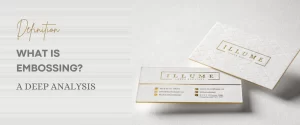
Let’s Book A Free Consultation
Discuss your packaging needs with our consultants free of cost by receiving a free call from our service center.
Use one of 3 options to approach us:

March 13, 2024 Blogs
To know the contrast between emboss vs. deboss, we should have an idea of what these words are and what place they have in the design and printing industry. Emboss vs deboss contributes to the aesthetically pleasing of a logo or a design. The techniques of embossing vs debossing appear as significant features for adding up the dimensions and texture of the material. Emboss vs deboss takes help from techniques to use pressure, heat, and metal plates consisting of a pattern, text, or a design. Opting for embossing vs debossing, one should know their unique applications, characteristics, and the appearance they form.
In emboss vs deboss embossing helps in creating a raised design, logo, or image on a surface. Embossing creates a 3D effect by cramming the front and back of the paper. You can feel the design or logo by moving your hand over it. Embossing is created by pressuring the back of a material, forcing it to poke out on the front side. It results in adding sophistication to the texture of the printed piece and is visually pleasing.


In comparison with emboss vs deboss, debossing is completely different. For debossing, the pressure is on the material downward rather than upward. It forms a recessed impression of the texture of the material. Debossing printing creates a graceful low-pitched surface that conveys a sense of refinement and luxury.
While contrasting emboss vs deboss, it is pivotal to consider the tactile and visual features they present:
Emboss vs deboss provides distinctive benefits and can be used to form various visual effects. Let us have a look at the factors taken into account when choosing between the two:
The decision of choosing the one between the two should align with the design objectives of the project. Embossing is used for forming eye-catching and bold elements, while debossing is best designated for adding a touch of sophistication and elegance to the texture.
Taking into consideration that the kind of material that is being used is what tells us the decision between debossing and embossing. With a wide range of substrates, both embossed vs debossed procedures are compatible. Some materials may result in the best way over the other. It’s necessary to keep in mind the characteristics of the material that is being used such as its texture, and thickness while determining.
It is very crucial to bear in mind the brand identity and the targeted audience when choosing between embossing and debossing. Each technique or way defines debossed vs embossed aesthetic and message. So, it’s important to select the one that best reflects the brand’s perception and values.
Embossing vs debossing offers multifaceted ways that can be used for various applications and industries. Let us look at the multiple examples of debossing vs embossing which can be considered:
The scope for embossing and debossing is expanding rapidly too. Advancements in printing materials and procedures are making it more simple, reasonable, and cost-effective for designers to engross their techniques into reality. From textured UV coatings to digital embossing, unique solutions are occurring for what’s possible in the industry of print design.
To conclude, we can see that embossing vs debossing are powerful tools for the addition of texture, dimension, and visual appeal to printed materials. The techniques for debossed vs embossed provides endless possibilities for creative impressions whether forming a bold statement or a subtle accent. By comprehending the contrast between debossing and embossing, the designers can captivate the targeted audience with their tactile, luxurious, and memorable touch.